Vahid Jamali
RIS-Assisted NOMA with Partial CSI and Mutual Coupling: A Machine Learning Approach
Aug 12, 2025Abstract:Non-orthogonal multiple access (NOMA) is a promising multiple access technique. Its performance depends strongly on the wireless channel property, which can be enhanced by reconfigurable intelligent surfaces (RISs). In this paper, we jointly optimize base station (BS) precoding and RIS configuration with unsupervised machine learning (ML), which looks for the optimal solution autonomously. In particular, we propose a dedicated neural network (NN) architecture RISnet inspired by domain knowledge in communication. Compared to state-of-the-art, the proposed approach combines analytical optimal BS precoding and ML-enabled RIS, has a high scalability to control more than 1000 RIS elements, has a low requirement for channel state information (CSI) in input, and addresses the mutual coupling between RIS elements. Beyond the considered problem, this work is an early contribution to domain knowledge enabled ML, which exploit the domain expertise of communication systems to design better approaches than general ML methods.
A Scalable Machine Learning Approach Enabled RIS Optimization with Implicit Channel Estimation
Aug 10, 2025Abstract:The reconfigurable intelligent surface (RIS) is considered as a key enabler of the next-generation mobile radio systems. While attracting extensive interest from academia and industry due to its passive nature and low cost, scalability of RIS elements and requirement for channel state information (CSI) are two major difficulties for the RIS to become a reality. In this work, we introduce an unsupervised machine learning (ML) enabled optimization approach to configure the RIS. The dedicated neural network (NN) architecture RISnet is combined with an implicit channel estimation method. The RISnet learns to map from received pilot signals to RIS configuration directly without explicit channel estimation. Simulation results show that the proposed algorithm outperforms baselines significantly.
Temperature-Resilient LC-RIS Phase-Shift Design for Multi-user Downlink Communications
May 08, 2025Abstract:The reflecting antenna elements in most reconfigurable intelligent surfaces (RISs) use semiconductor-based (e.g., positive-intrinsic-negative (PIN) diodes and varactors) phase shifters. Although effective, a drawback of this technology is the high power consumption and cost, which become particularly prohibitive in millimeter-wave (mmWave)/sub-Terahertz range. With the advances in Liquid Crystals (LCs) in microwave engineering, we have observed a new trend in using LC for realizing phase shifter networks of RISs. LC-RISs are expected to significantly reduce the fabrication costs and power consumption. However, the nematic LC molecules are sensitive to temperature variations. Therefore, implementing LC-RIS in geographical regions with varying temperatures requires temperature-resilient designs. The mentioned temperature variation issue becomes more significant at higher temperatures as the phase shifter range reduces in warmer conditions, whereas it expands in cooler ones. In this paper, we study the impact of temperature on the operation of LC-RISs and develop a temperature-resilient phase shift design. Specifically, we formulate a max-min signal-to-interference-plus-noise ratio optimization for a multi-user downlink mmWave network that accounts for the impact of temperature in the LC-RIS phase shifts. The simulation results demonstrate a significant improvement for the considered set of parameters when using our algorithm compared to the baseline approach, which neglects the temperature effects.
Fast Reconfiguration of LC-RISs: Modeling and Algorithm Design
Apr 11, 2025Abstract:LC technology is a promising hardware solution for realizing extremely large RISs due to its advantages in cost-effectiveness, scalability, energy efficiency, and continuous phase shift tunability. However, the slow response time of the LC cells, especially in comparison to the silicon-based alternatives like radio frequency switches and PIN diodes, limits the performance. This limitation becomes particularly relevant in TDMA applications where RIS must sequentially serve users in different locations, as the phase-shifting response time of LC cells can constrain system performance. This paper addresses the slow phase-shifting limitation of LC by developing a physics-based model for the time response of an LC unit cell and proposing a novel phase-shift design framework to reduce the transition time. Specifically, exploiting the fact that LC-RIS at milimeter wave bands have a large electric aperture, we optimize the LC phase shifts based on user locations, eliminating the need for full channel state information and minimizing reconfiguration overhead. Moreover, instead of focusing on a single point, the RIS phase shifters are designed to optimize coverage over an area. This enhances communication reliability for mobile users and mitigates performance degradation due to user location estimation errors. The proposed design minimizes the transition time between configurations, a critical requirement for TDMA schemes. Our analysis reveals that the impact of RIS reconfiguration time on system throughput becomes particularly significant when TDMA intervals are comparable to the reconfiguration time. In such scenarios, optimizing the phase-shift design helps mitigate performance degradation while ensuring specific QoS requirements. Moreover, the proposed algorithm has been tested through experimental evaluations, which demonstrate that it also performs effectively in practice.
Temperature-Aware Phase-shift Design of LC-RIS for Secure Communication
Nov 19, 2024



Abstract:Liquid crystal (LC) technology enables low-power and cost-effective solutions for implementing the reconfigurable intelligent surface (RIS). However, the phase-shift response of LC-RISs is temperature-dependent, which, if unaddressed, can degrade the performance. This issue is particularly critical in applications such as secure communications, where variations in phase-shift response may lead to significant information leakage. In this paper, we consider secure communication through an LC-RIS and developed a temperature-aware algorithm adapting the RIS phase shifts to thermal conditions. Our simulation results demonstrate that the proposed algorithm significantly improves the secure data rate compared to scenarios where temperature variations are not accounted for.
LiquiRIS: A Major Step Towards Fast Beam Switching in Liquid Crystal-based RISs
Oct 28, 2024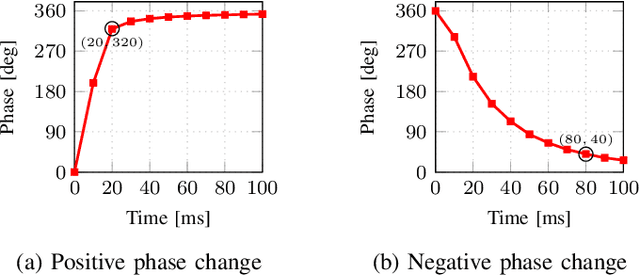
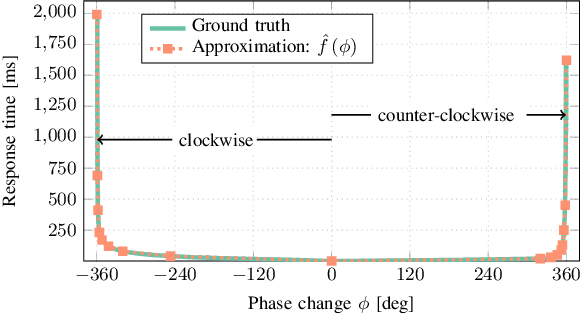
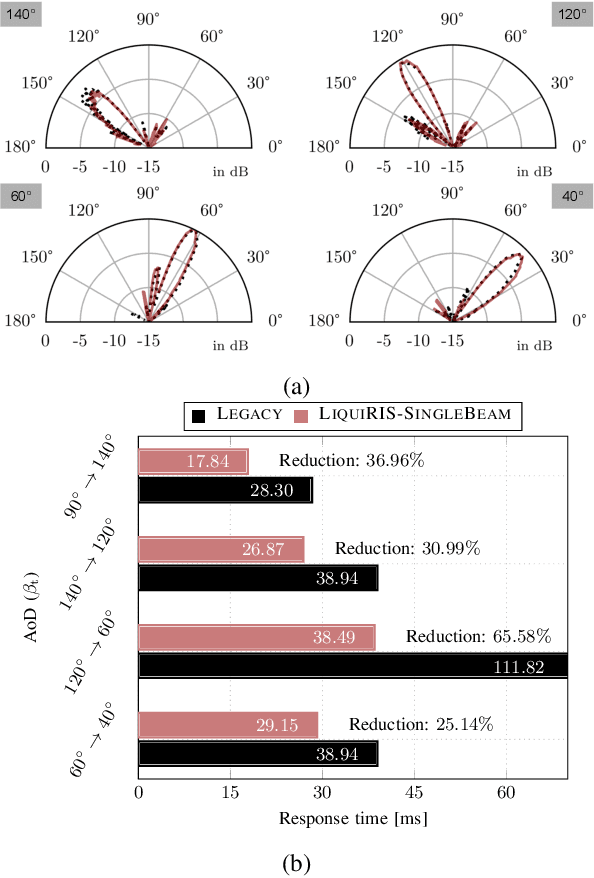
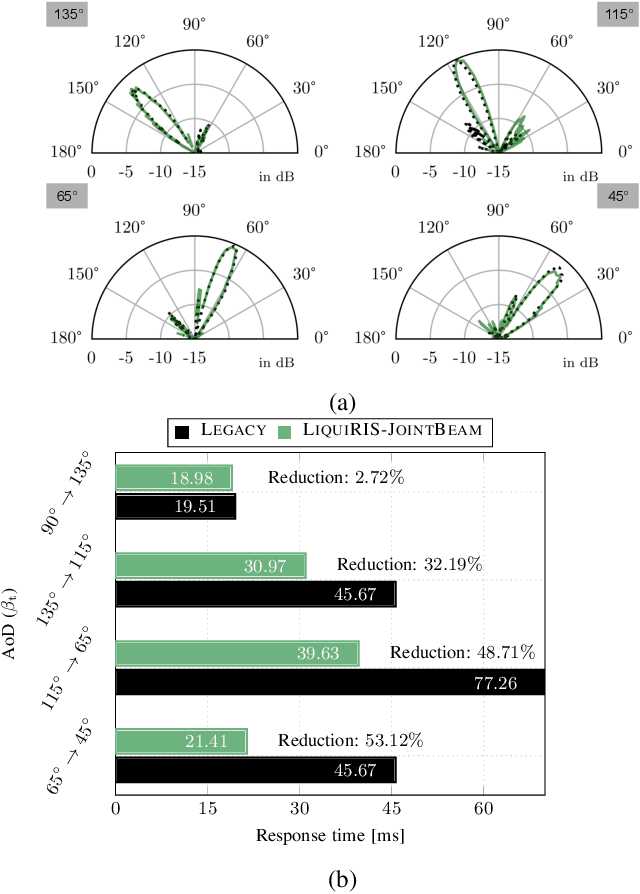
Abstract:Reconfigurable intelligent surfaces (RISs) offer enhanced control over propagation through phase and amplitude manipulation but face practical challenges like cost and power usage, especially at high frequencies. This is specifically a major problem at high frequencies (Ka- and V-band) where the high cost of semiconductor components (i.e., diodes, varactors, MEMSs) can make RISs prohibitively costly. In recent years, it is shown that liquid crystals (LCs) are low-cost and low-energy alternative which can address the aforementioned challenges but at the cost of lower response time. In LiquiRIS, we enable leveraging LC-based RIS in mobile networks. Specifically, we devise techniques that minimize the beam switching time of LC-based RIS by tapping into the physical properties of LCs and the underlying mathematical principles of beamforming. We achieve this by modeling and optimizing the beamforming vector to account for the rotation characteristics of LC molecules to reduce their transition time from one state to another. In addition to prototyping the proposed system, we show via extensive experimental analysis that LiquiRIS substantially reduces the response time (up to 70.80%) of liquid crystal surface (LCS).
Fronthaul-Constrained Distributed Radar Sensing
Sep 26, 2024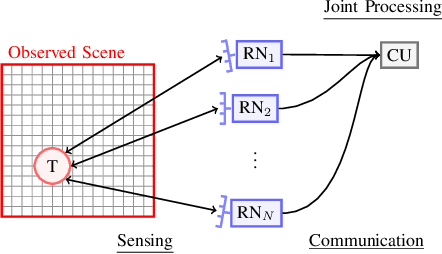
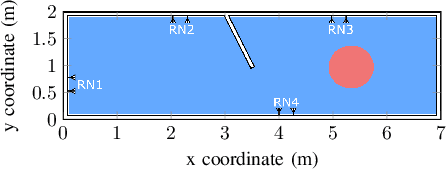
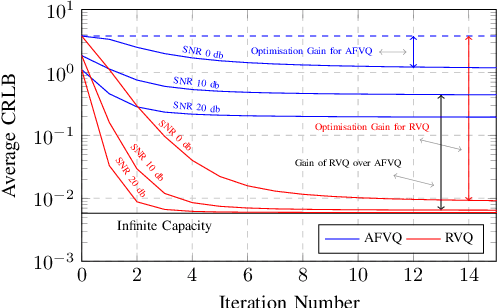
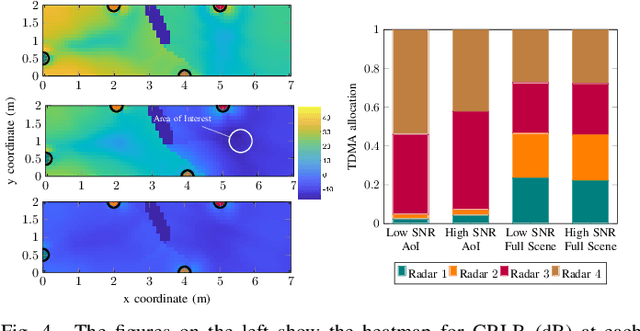
Abstract:In this paper, we study a network of distributed radar sensors that collaboratively perform sensing tasks by transmitting their quantized radar signals over capacity-constrained fronthaul links to a central unit for joint processing. We consider per-antenna and per-radar vector quantization and fronthaul links with dedicated resources as well as shared resources based on time-division multiple access. For this setting, we formulate a joint optimization problem for fronthaul compression and time allocation that minimizes the Cramer Rao bound of the aggregated radar signals at the central unit. Since the problem does not admit a standard form that can be solved by existing commercial numerical solvers, we propose refomulations that enable us to develop an efficient suboptimal algorithm based on semidefinite programming and alternating convex optimization. Moreover, we analyze the convergence and complexity of the proposed algorithm. Simulation results confirm that a significant performance gain can be achieved by distributed sensing, particularly in practical scenarios where one radar may not have a sufficient view of all the scene. Furthermore, the simulation results suggest that joint fronthaul compression and time allocation are crucial for efficient exploitation of the limited fronthaul capacity.
Near-Field Multipath MIMO Channel Model for Imperfect Surface Reflection
Sep 25, 2024



Abstract:Near-field (NF) communications is receiving renewed attention in the context of passive reconfigurable intelligent surfaces (RISs) due to their potentially extremely large dimensions. Although line-of-sight (LOS) links are expected to be dominant in NF scenarios, it is not a priori obvious whether or not the impact of non-LOS components can be neglected. Furthermore, despite being weaker than the LOS link, non-LOS links may be required to achieve multiplexing gains in multi-user multiple-input multiple-output (MIMO) scenarios. In this paper, we develop a generalized statistical NF model for RIS-assisted MIMO systems that extends the widely adopted point-scattering model to account for imperfect reflections at large surfaces like walls, ceilings, and the ground. Our simulation results confirm the accuracy of the proposed model and reveal that in various practical scenarios, the impact of non-LOS components is indeed non-negligible, and thus, needs to be carefully taken into consideration.
Delay Dispersion in IRS-assisted FSO Links
Mar 14, 2024Abstract:The line-of-sight (LOS) requirement of free-space optical (FSO) systems can be relaxed by employing optical intelligent reflecting surfaces (IRSs). In this paper, we model the impact of the IRS-induced delay dispersion and derive the channel impulse response (CIR) of IRS-assisted FSO links. The proposed model takes into account the characteristics of the incident and reflected beams' wavefronts, the position of transmitter and receiver, the size of the IRS, and the incident beamwidth on the IRS. Our simulation results reveal that a maximum effective delay spread of 0.7 ns is expected for a square IRS with area 1 $\mathrm{m}^2$, which induces inter-symbol interference for bit rates larger than 10 Gbps. We show that the IRS-induced delay dispersion can be mitigated via equalization at the receiver.
User Tracking and Direction Estimation Codebook Design for IRS-Assisted mmWave Communication
Mar 11, 2024Abstract:Future communication systems are envisioned to employ intelligent reflecting surfaces (IRSs) and the millimeter wave (mmWave) frequency band to provide reliable high-rate services. For mobile users, the time-varying channel state information (CSI) requires adequate adjustment of the reflection pattern of the IRS. We propose a novel codebook-based user tracking (UT) algorithm for IRS-assisted mmWave communication, allowing suitable reconfiguration of the IRS unit cell phase shifts, resulting in a high reflection gain. The presented algorithm acquires the direction information of the user based on a peak likelihood-based direction estimation. Using the direction information, the user's trajectory is extrapolated to proactively update the adopted codeword and adjust the IRS phase shift configuration accordingly. Furthermore, we conduct a theoretical analysis of the direction estimation error and utilize the obtained insights to design a codebook specifically optimized for direction estimation. Our numerical results reveal a lower direction estimation error of the proposed UT algorithm when employing our designed codebook compared to codebooks from the literature. Furthermore, the average achieved signal-to-noise ratio (SNR) as well as the average effective rate of the proposed UT algorithm are analyzed. The proposed UT algorithm requires only a low overhead for direction and channel estimation and avoids outdated IRS phase shifts. Furthermore, it is shown to outperform two benchmark schemes based on direct phase shift optimization and hierarchical codebook search, respectively, via computer simulations.
 Add to Chrome
Add to Chrome Add to Firefox
Add to Firefox Add to Edge
Add to Edge